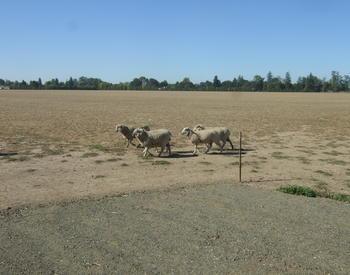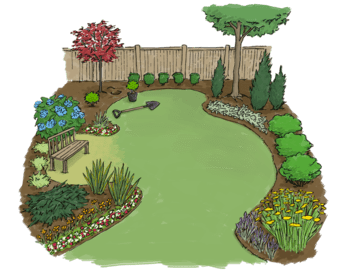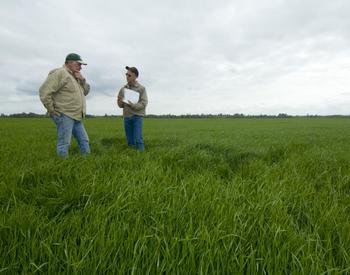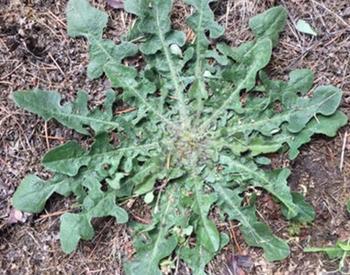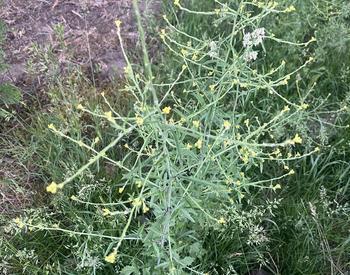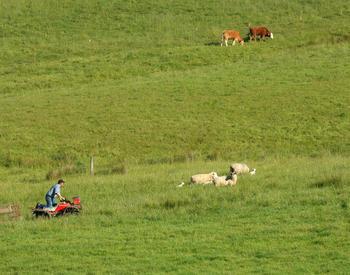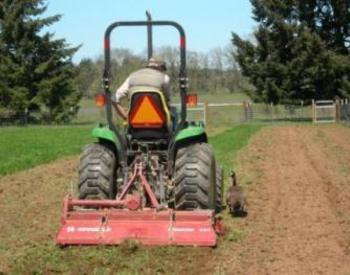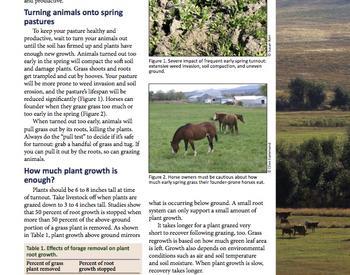As summer approaches and the soil dries, forage plants become dormant. In some years in drier areas of Oregon, dormancy may begin as early as late spring. If you have irrigation rights, your pastures can provide supplemental nutrition even during the dry summer months. Here are some tips to help you schedule and monitor your pasture irrigation system.
Many of these tips for pastures also may apply to other crops.
Oregon producers use a number of irrigation methods, including flood, hand line, wheel line, gated pipe, linear, pivot, pod systems, and little and big gun irrigation systems. The method of choice depends on the system that came with the farm, the size of the farm, and the amount of labor, time and money available. Some small farms use solid set systems for pasture. These systems are efficient but require care to protect the pipe from the livestock.
Determining when to irrigate and how much water to apply are specialized tasks. Though many techniques exist, the easiest irrigation scheduling technique may be to monitor soil moisture. This technique can help you determine when to irrigate, whether irrigation periods are sufficiently spaced, and whether the proper amount of water is applied during each irrigation.
During the growing season, the soil should dry out to about 50% of the soil water-holding capacity before it is irrigated back to its capacity. Water-holding capacity is determined by soil texture, organic matter content and soil depth. The time between irrigations varies depending on the time of year. For instance, during spring in Central Oregon, the frequency of irrigation could be every two to three weeks. In the summer, producers could irrigate as often as every five days, depending upon the water-holding capacity of the soil.
Moisture evaporates from soil, and plants are said to transpire — that is, they give off moisture through their leaves. Considered together, these two processes are referred to as evapotranspiration. Evapotranspiration, or average daily water loss from the soil-plant system, varies by season. As you might guess, water losses are greater during the hot, dry, longer days of summer than at any other time of year.
If your goal is to have a green pasture, irrigate whenever the weather is dry.
If you irrigate for production, follow an irrigation management plan based on the infiltration rate, the water-holding capacity of the soil, and the amount of moisture lost to evapotranspiration. Use weather and soil information to ensure adequate but not excessive irrigation. This information is available for a variety of areas of Oregon through AgriMet. An irrigation specialist at the local USDA Natural Resources Conservation Service office or OSU Extension's irrigation specialist can help you develop a water management plan.
Do not leave large livestock in the pasture while irrigating; they may damage equipment. To avoid plant damage and soil compaction, wait three or four days after irrigating before turning large livestock back onto pastures. As always, wait until the pasture is above 6 to 8 inches in height before grazing, and graze no shorter than 3 inches.
Irrigation tips for sprinkler systems
- Never use a nozzle smaller than 9/64 inch.
- Repair all hole and gasket leaks.
- Irrigate during low wind periods.
- Maintain adequate nozzle pressure — 50-60 psi.
- Use the same nozzle size throughout the system.
- Invest in a soil probe, a pitot tube, an oil-filled pressure gauge and a drill bit to check for nozzle wear.
- Pressure drop from the pump to the first nozzle should not exceed 10%.
- Pressure drop from the pump to the last nozzle should not exceed 20%.
- Sprinkler systems are designed with a 50% overlap for efficient water distribution.
- Every gallon of water pumped is reflected in energy costs.
For more information:
- Estimating Soil Moisture by Feel and Appearance, NRCS, USDA. This is a classic field aid to irrigation management.
- AgriMet. Oregon Crop Water Use Charts. Pacific Northwest Region, Bureau of Reclamation.
- For more information on irrigation scheduling methods and other water use issues, consult the Center of Irrigation Technology, Fresno State University.
